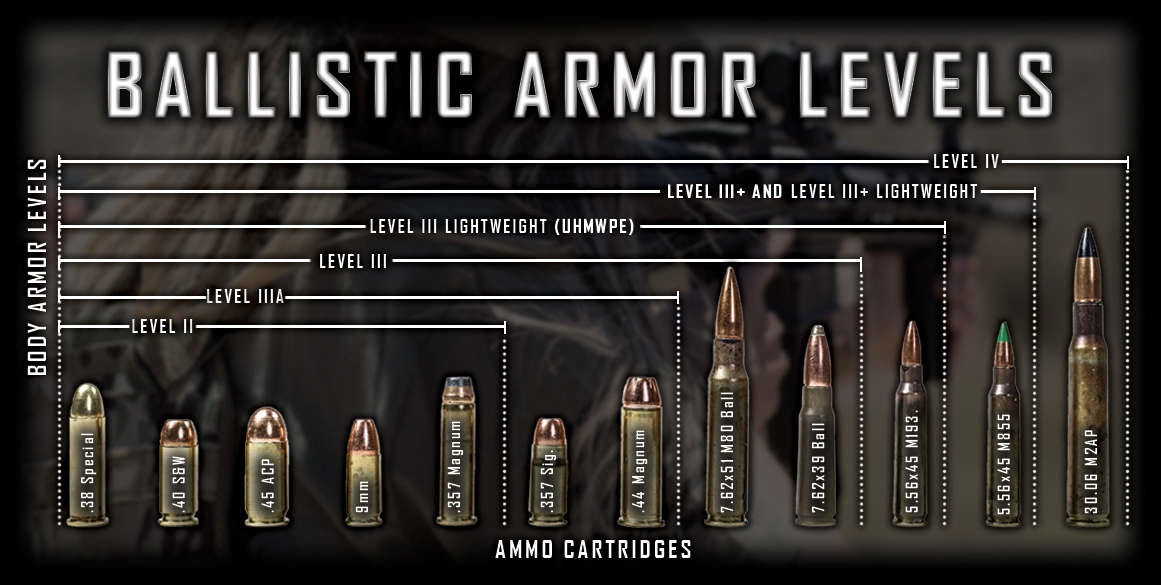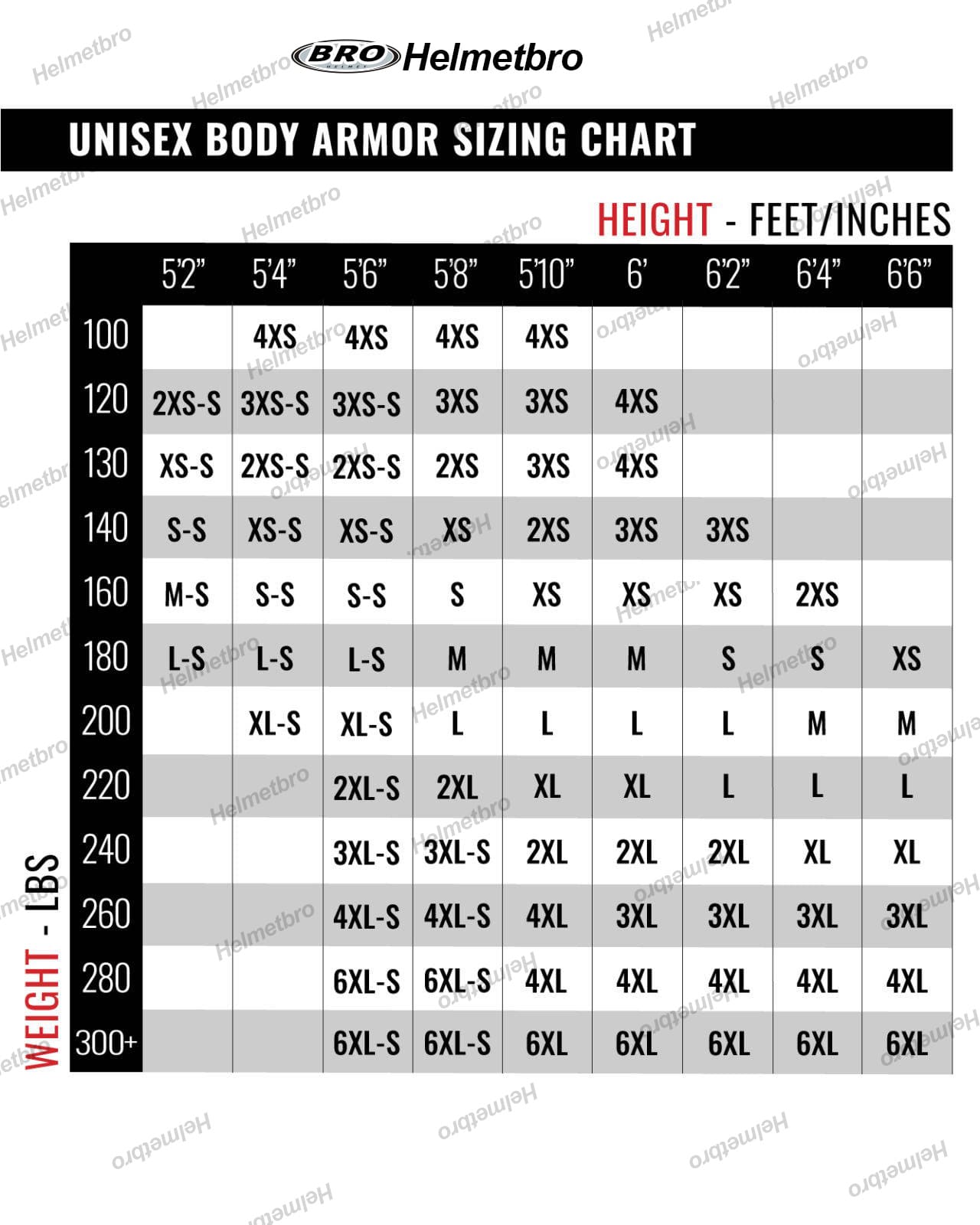Body Armor Grades And Standards
Oct 21, 2023
Body armor grades and standards
Body armor is also called bulletproof armor and bulletproof vest. Regarding the bulletproof level, each country has different markings. Next, please allow me to take you to re-understand the levels and standards of defense body jackets in various countries.
Words you may not know:
Back concave depth: The depth of the concave back of the body armor after being deformed by a bullet impact. The greater the depth, the more likely the user is to "break a rib."
FMJ/FMSJ bullet: full metal jacket bullet, a common bullet.
JSP/SJSP bullet: Semi-armored soft-point bullet, the so-called "Dum bullet", a type of ammunition that sacrifices armor-piercing performance in exchange for lethality against soft targets (human bodies).
JHP/SJHP bullets: semi-armored hollow point bullets, similar to DUM bullets but with stronger soft target killing capabilities than DUM bullets.
FMS bullet: full metal pointed bullet, a German pistol bullet with a cone-shaped bullet, which has stronger armor-piercing ability.
United States:

1) NIJ 0101.06 standard:
The NIJ 0101.06 standard was developed by the National Institute of Justice to address the needs of law enforcement agencies for body armor. The latest version 6 standard was formulated in 2008 and will be replaced by the NIJ 0101.07 standard in 2021.
Due to various reasons, this national standard has become the most widely known standard in the world, worthy of being "Home of the brave, Land of the freedom". In addition, although it is very famous, this standard is still used by American policemen, and is relatively insufficient in the military field.
The NIJ standard has the deepest recess depth of all standards.
The depth of the back recess shall not exceed 1.73inch/44mm.
Type IIA: Capable of blocking 9*19mm round-nose FMJ bullets and .40 S&W FMJ bullets.
Type II: Can block 9*19mm round-nose FMJ bullets and .357 Magnum JSP bullets.
Type IIIA: Capable of stopping .357 SIG flat nose FMJ rounds and .44 Magnum SJHP rounds.
Type III: Able to block 7.62*51mm FMJ (US military code M80) bullets.
Type IV: Capable of stopping .30-06 M2 armor-piercing rounds.
2) NIJ 0106.01 (modified) standard:
The NIJ 0106.01 standard is a standard for measuring the ballistic protection performance of helmets and was established by the National Institute of Justice in 1981. In order to save the old regulations that were out of date, they made some changes to it at some point and added a IIIA rating.
Type I: Can stop .22 LR high-velocity lead bullets and .38 Special round-nose lead bullets.
Type IIA: Can block 9*19mm round-nose FMJ bullets and .357 Magnum JSP bullets fired from 4~4.75-inch barrels.
Type II: Can block 9*19mm round-nose FMJ bullets and .357 Magnum JSP bullets fired from 6~6.75-inch barrels.
Type IIIA: Capable of stopping .357 SIG flat nose FMJ rounds and .44 Magnum SJHP rounds.

3) US military body armor standards
Although the US military's body armor still uses NIJ ratings, the US military has additional needs for different batches of body armor and bulletproof inserts during procurement. These requirements are more scientific, and there are refinements and further improvements in performance indicators. They are more mature than the crude NIJ standards.
2. China GA 141-2010 standard:
On October 17, 2010, the Ministry of Public Security of the People's Republic of China issued the GA 141-2010 police body armor standard that replaced GA 141-2001, standardizing the types of ammunition used in testing and modifying the requirements for the protective area of body armor. This is not More details.
The depth of the back recess shall not exceed 25mm.
Level 1: Able to block 7.62*17mm lead core pistol bullets.
Level 2: Able to block 7.62*25mm lead core pistol bullets.
Level 3: Capable of blocking 7.62*25mm lead-core pistol bullets fired from the Type 79 submachine gun with a long barrel.
Level 4: Capable of blocking 7.62*25mm steel core pistol bullets fired by the Type 79 submachine gun with a long barrel.
Level 5: Able to block 7.62*39mm Type 56 ordinary bullets.
Level 6: Able to block 7.62*54mm Type 53 ordinary bullets
3. Russia:
1) GOST R 50744-95 old standard:
A relatively detailed measurement system, Takovli's various bulletproof equipment uses this standard.
The depth of the back recess shall not exceed 16mm.
Class 1: Able to block 9*18mm Makarov (57-N-181S) bullets and 7.62*38mm Nagant revolver bullets.
Class 2: Able to block 5.45×18mm MPTs 7N7 bullets and 7.62*25mm Tokarev bullets
Class 2A: Can stop 12-gauge shotshells.
Class 3: Able to block 5.45×39mm 7N6 hard steel core bullets and 7.62×39mm 57-N-231 hard steel core bullets.
Class 4: Able to block 5.45×39mm 7N10 armor-piercing reinforced hard steel core bullets.
Class 5: Able to block 7.62×54mmR 57-N-323S hard steel core bullets and 7.62×39mm 57-N-231 hard steel core bullets.
Class 5A: Able to block 7.62×39mm 57-BZ-231 (BZ API) armor-piercing incendiary bombs.
Class 6: Able to block 7.62×54mmR 7N13 armor-piercing reinforced hard steel core bullets.
Class 6A: Able to block 7.62×54mmR 7-BZ-3 (B32 API) armor-piercing incendiary bombs.
2) GOST R 50744-95 new standard:
The new standards implemented in 2017 have integrated and removed some of the old standards that were overly cumbersome, and added two new levels of bulletproofing - the BR6 standard is really outrageous. I really didn't expect the Russians to have come up with it. It is a body armor that can block 12.7*108mm without being exhausted after just a few steps.
The depth of the back recess shall not exceed 16mm.
BR1: Able to block 9*18mm Makarov (57-N-181S) bullets.
BR2: Able to block 9*21mm Viper 7N28 lead core bullets.
BR3: Able to block 9*19mm Parabellum 7N21 hard steel core bullets.
BR4: Able to block 5.45×39mm 7N10 armor-piercing reinforced hard steel core bullets and 7.62×39mm 57-N-231 hard steel core bullets.
BR5: Able to block 7.62×54mmR 7N13 armor-piercing reinforced hard steel core bullets and 7.62×54mmR 7-BZ-3 (B32 API) armor-piercing incendiary bullets.
BR6: Able to block 12.7×108mm 57-BZ-542 armor-piercing incendiary bombs.
4. United Kingdom:
1) British HOSDB standard (2007 edition):
The HOSDB standard was first formulated in 1993 by the Home Office Scientific Development Branch of the United Kingdom. Similar to the NIJ standard, it was developed to provide protection for the police in England, but unlike the NIJ 0101.06 standard, the HOSDB standard also covers stabbing protection standards for props and cold weapons such as spears.
Only the bulletproof standard part of HOSDB is excerpted here.
In 2003, the Scientific Development Office of the Ministry of Interior added the HG1/A bulletproof level. This bulletproof level is exactly the same as the HG1 level except that the upper limit of the back concave depth is increased to 44mm.
Except for the upper limit of back recess depth of HG1/A, which is 44mm, the other back recess depths shall not exceed 25mm.
HG1: Can block 9*19mm FMJ bullets and .357 Magnum JSP bullets.
HG1/A: Can block 9*19mm FMJ bullets and .357 Magnum JSP bullets.
HG2: Can block 9*19mm FMJ bullets and .357 Magnum (requiring higher bullet muzzle velocity, which can be understood as pistol bullets fired from long barrel submachine guns/PCC) JSP bullets.
HG3: Can block 5.56*45mm NATO (LE223T3) bullets.
RF1: Able to block 7.62*51mm NATO (L2 A2) rounds.
RF2: Able to block 7.62*51mm high-power (L40 A1) bullets.
SG1: Can block No. 12 shotgun.
2) British HOSDB standard (2017 version)
In 2017, the UK updated its HOSDB standard, which was reportedly changed based on user needs.
HO1: Can block 9*19mm FMJ bullets and 9*19mm JHP bullets. There is no average recess depth requirement, but the maximum recess depth shall not exceed 44mm.
HO2: Able to block 9*19mm FMJ bullets and 9*19mm JHP bullets (requiring higher warhead muzzle velocity, which can be understood as pistol bullets fired from submachine guns/PCCs with long barrels). The average depth of back recess must not exceed 25mm, and the maximum depth of back recess must not exceed 44mm.
HO3: Can block 7.26*51mm NATO (L44A1 or L2A2) bullets and 7.62×39mm bullets. The average depth of recess must not exceed 25mm, and the maximum depth of recess must not exceed 30mm.
HO4: Can block the .308 Win (warhead number 480A) bullet produced by Sako Company, or the .308 TSX BT bullet produced by Barnes Company. The average depth of recess must not exceed 25mm, and the maximum depth of recess must not exceed 30mm.
SG1: Can block No. 12 shotgun. The average depth of recess must not exceed 25mm, and the maximum depth of recess must not exceed 30mm.
Three special levels of optional testing:
Capable of stopping .357 Magnum flat-head SP rounds. There is no average recess depth requirement, but the maximum recess depth shall not exceed 44mm.
Can block 5.56*45mm SS109 (L17A1h or L15A1) bullets. The average depth of recess must not exceed 25mm, and the maximum depth of recess must not exceed 30mm.
Able to block 5.56*45mm (LE223T3) bullets. The average depth of recess must not exceed 25mm, and the maximum depth of recess must not exceed 30mm.
5. German TR standards:
Germany's TR (Technische Richtlinie) was proposed in 2008 and is based on the VPAM standard. This may be the most common testing standard in Europe. The biggest difference between it and the NIJ standard is that the TR standard will test pistol armor-piercing bullets, while the NIJ will not.
The depth of the back recess shall not exceed 42mm.
SK L: Able to block 9*19mm DM 41 round nose lead core FMJ bullets.
SK 1: Able to block 9*19mm DM 41 round nose lead core FMJ bullets, 9*19mm QD-PEP II/S special police bullets and 9*19mm Action 4 special police bullets.
SK2: Capable of blocking .357 Magnum FMS rounds.
SK3: Can block 5.56*45mm SS109 bullets and 7.62*51mm DM111 steel core bullets.
SK4: Can block 7.62*51mm P80 armor-piercing bullets.
6. Australia and New Zealand AS/NZS 2343:1997 standard:
There is nothing much to say about the standard developed by Australia and New Zealand in 1997. The only feature is that it adds a protection standard for shotgun single-head bullets.
I can't even find the recess depth requirements for this thing.
G0: Can block 9*19mm Mk 2Z bullets.
G1: Capable of stopping .357 Magnum SJSP flathead bullets.
G2: Capable of stopping .44 Magnum SJSP flathead rounds.
R1: Can block 5.56*45mm M193 bullets.
R2: Able to block 7.62*51mm 9.3g warhead NATO bullets.
S1: Can block No. 12 shotgun.
S2: Can block No. 12 single-headed bomb.
7. The ISO 14876-2 standard released by the Netherlands in 2000.
The maximum back recess depth shall not exceed 44mm.
1: Able to block 9*19mm FMSJ bullets.
2: Able to block 9*19mm FMSJ bullets (requiring higher warhead muzzle velocity, which can be understood as pistol bullets fired from long barrel submachine guns/PCCs).
3: Able to block 9*19mm FMSJ bullets and .357 Magnum FMJ bullets (requiring higher warhead muzzle velocity, which can be understood as pistol bullets fired from long barrel submachine guns/PCCs).
4: Able to block 5.56*45mm M193 bullets and 7.62*51mm 9.3g warhead NATO bullets.
5: Able to block 7.62*51mm 9.7g warhead hard steel core armor-piercing bullets.
S: Can block No. 12 single-headed bombs.
How to choose the correct body armor size?



